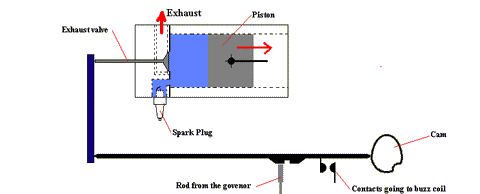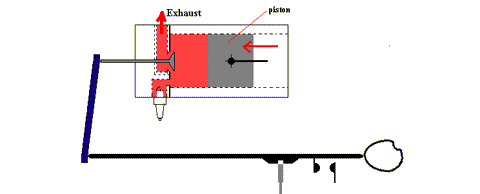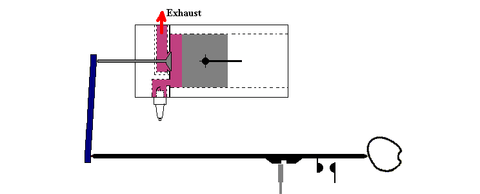
Hit and Miss Engine
What's Hit and Miss Engine?
A hit-and-miss engine is a type of four-stroke internal combustion engine that is controlled by a governor to operate at a set speed. It was conceived in the late 19th century and produced by various companies from the 1890s through approximately the 1940s. The name comes from the speed control on these engines: they fire ("hit") only when operating at or below a set speed, and cycle without firing ("miss") when they exceed their set speed. This is as compared to the "throttle governed" method of speed control. The sound made when the engine is running without a load is a distinctive "POP whoosh whoosh whoosh whoosh POP" as the engine fires and then coasts until the speed decreases and it fires again to maintain its average speed.
Working Principle Explanation - The "Hit and Miss" Engine
1st, we will look at the "Hit" state.
Each time the engine intakes the gas it takes a full charge. There is no butterfly in a hit and miss mixer. So the engine wants to go faster and faster.
Here are the Four cycles (4 strokes) of the "Hit" state.
1, Intake Cycle
The intake cycle is where the piston is moving to the right or away from the head. As it does, it creates a vacuum in the cylinder and that pulls the air and fuel into the cylinder. The intake valve is not shown here, and is just on a spring to keep it in the closed position. As the vacuum increases it pulls the intake valve open and the air/fuel mix enters.

2, Compression Cycle
In the compression cycle, all valves close and the piston moves to the left or towards the head. As it does, the mixture compresses making it very volatile.

3, Fire Cycle
In the Fire Cycle , the contacts to the "buzz" coil closed and that fires the spark plug pushing the piston to the right or away from the head. Notice in the fire cycle, the cam allows the exhaust rod to dip backwards, allowing the contacts to close and fire the spark plug.

4, Exhaust Cycle
In the Exhaust Cycle , the exhaust valve opening and the piston pushing out the exhaust. (If the exhaust valve isn't moving at all, it's because it is in the "Miss" state or slowing down.)

Summary:
Anamated Four Cycles ("Hit" State)
You will see the entire operation animated. Notice in the fire cycle, the cam allows the exhaust rod to dip backwards, allowing the contacts to close and fire the spark plug.

2nd, So how do we "govern" the engine? - Govenor in locked posision ("Miss" State)
As the govenor runs too fast it pushes the govenor rod into the exhaust push rod and traps it (see Pic below). This allows the exhaust valve to stay open all the time. No vacuume is made by the piston so no fuel can enter into the cylinder. Also the contact going to the "buzz" coil will not close, so the spark plug never fires. The engine just "free wheels" or coasts. Finally is slows too much and the govenor removes it's rod and the entire engine returns to the "Hit" state.
Below you will see two four stroke cycle in the "Hit" state then two four stroke cycles in the "Miss" state.

Hit and Miss - Controls the engines speed by cutting off the engines ignition system when it runs too fast. This is the "miss" part. When the engine slows too much, it allows it to "hit" again and pick speed back up. Throttle Governed - Controls the engine speed by controlling a butterfly in the carb.
How Poeple DIY Hit and Miss Engine in Daily Life?
Hit and Miss Engine - Grab Now : https://www.enginediy.com/products/hit-and-miss-engine-full-metal-internal-combustion-engine

Leave a comment